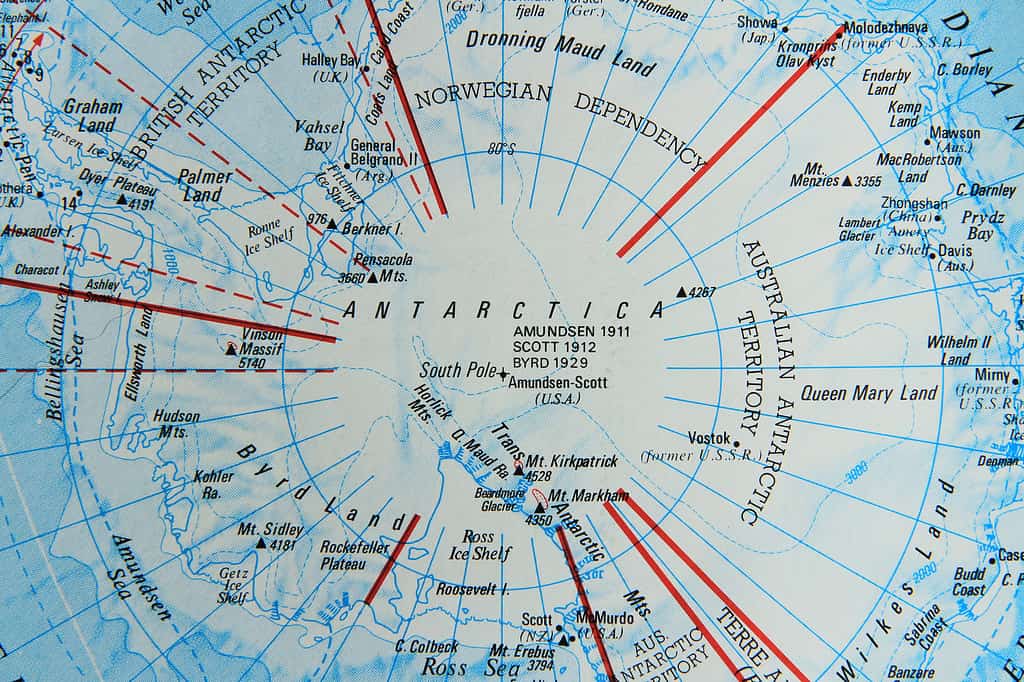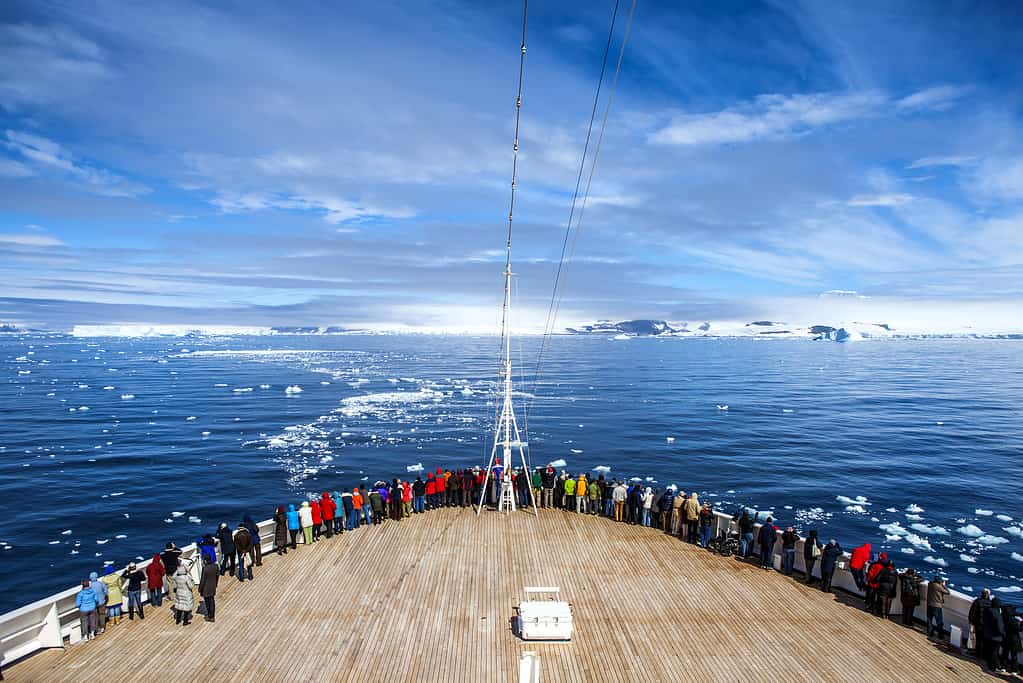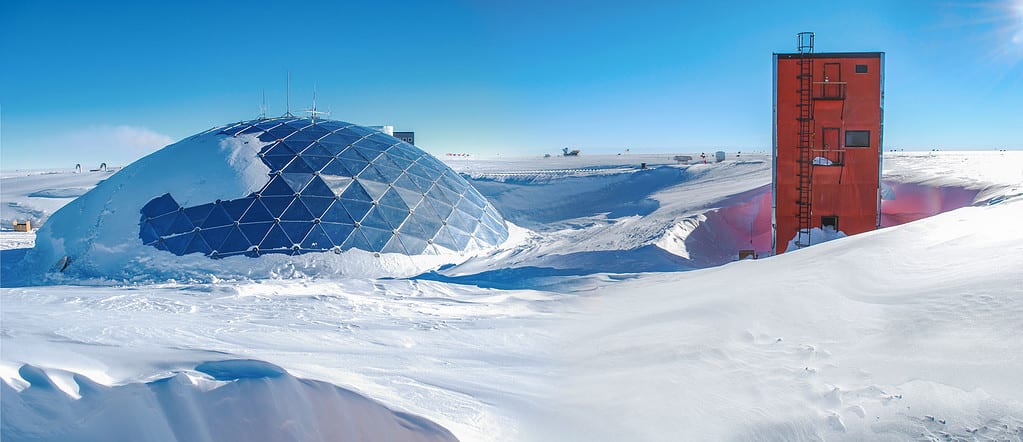Known as the coldest place on Earth, the South Pole is a place that is known for scientific exploration. While most people know that the South Pole is in the southern part of the globe, they might not know exactly where that point is on a map. If you’re wondering, we can help inform you where the South Pole is on a map and its surrounding countries.
Where Is the South Pole on a Map?
The South Pole is located on the southernmost point on the planet and is one of the two points on Earth’s axis. Location-wise, the South Pole is in Antarctica, a mass of land with seven territorial claims. Currently, the United States Amundsen-Scott South Pole Station is established.
The Geography of the South Pole

The South Pole has a unique geography, such as flat ice caps and a high elevation above sea level.
©Bobtokyoharris/iStock via Getty Images
Known as the Geographical South Pole, the southernmost point sits upon Earth’s axis of rotation, but it’s not stagnant as the planet wobbles due to polar motion. It’s the polar opposite of the North Pole, which is located in the Arctic Ocean. As for the coordinates, it’s 90°S with a 0° longitude.
The location sits atop an icy plateau nearly 9,301 feet above sea level. At the center point, it’s 810 miles from the Bay of Whales, which is the closest spot of open water. Surrounding the area are just ice sheets, estimated to be 8,900 feet thick.
While the point of the South Pole doesn’t shift, the land around it does. Since continental drift is consistently causing land to move, each year, the point of it on the land slightly changes. On New Year’s, a stake and sign are moved to represent the new location accurately.
What is the Climate in the South Pole?
The South Pole has unique weather compared to anywhere else in the world. Climates can change instantly, and there is varying weather throughout the year. Notoriously, it is known for having frightening winters, where it’s almost impossible for machinery or creatures to exist outdoors unless equipped specially for the weather.
Climate
Mainly, the land is ice-capped and almost resembles a snowy desert. While the air humidity is almost zero, high winds can cause extreme conditions. Not only is the snowfall almost blizzard-like due to the wind, but it also causes an accumulation of snow, which amounts to around 2.8 inches yearly.
Sunlight
Like other areas in the southern or northern hemisphere, the South Pole experiences consistent darkness throughout its winter from May through August. There is no sunlight, not even for a few hours. Instead, the only light illuminating the landscape is from the moonlight.
During the summer, November through February, the sun is low in the sky and is close to the horizon. Only a small amount of sunlight reaches the surface of the ground. Most light is reflected off the icy snow, which helps illuminate the ground.
Altitude
The altitude works a bit differently from other places in the world. The South Pole sits at 9,200 feet and has an intense centrifugal force, which makes the altitude feel more intense. Due to this, the South Pole is colder than the North Pole. Additionally, the elevation, location, and sea make the temperatures colder.
Temperatures
Temperatures are generally extreme and vary greatly depending on the time of year. During summer, the average temperature tends to be -15 degrees Fahrenheit. The temperatures also drop as the sun becomes less frequent in the skies. At its lowest, it can reach -67 degrees Fahrenheit during March and September.
Winter is when the extreme temperatures become the norm. In midwinter, the average temperature floats around -76 degrees Fahrenheit. The highest temperature during the winter was recorded to be 9.9 degrees Fahrenheit. However, the lowest temperature recorded at the South Pole was -117 degrees Fahrenheit on 23 June 1982.
How Far Is the South Pole from Other Countries?
| Country/City | Distance to South Pole (Miles) |
|---|---|
| Argentina (Ushuaia) | 2,432.66 |
| Chile (Punta Arenas) | 2,546.24 |
| New Zealand (Christchurch) | 2,800 |
| South Africa (Cape Town) | 3,874.5 |
| Australia (Hobart) | 9,088.04 |
The South Pole is on Antarctica’s continent with no cities or villages. It’s a landmass covered by ice and is mainly uninhabitable, besides a handful of research sites. However, multiple ways to get there from the closest surrounding countries exist.
The closest surrounding countries are the following:
The closest countries to Antarctica are Chile and Argentina, on the South American continent. Chile is the world’s southernmost country and has the shortest distance.
Can You Travel to the South Pole?

Cruise ships to flights travel from multiple cities worldwide to the South Pole. The biggest issue is the price, which ranges from $9,000 to $50,000.
©Marc-Andre_LeTourneux/iStock via Getty Images
While you can’t just go to the South Pole unless you’re willing to shill out a bunch of money, some Antarctic gateway cities allow travel close to Antarctica. The cruises often circle the continent without getting too close to the territory. Passengers aren’t allowed off the boat but can see the continent from afar.
The closest surrounding gateway cities are as follows:
- Punta Arenas, Chile
- Ushuaia, Argentina
- Cape Town, South Africa
- Hobart, Australia
- Christchurch, New Zealand
Out of the gateway cities, the closest to the South Pole is Ushuaia, Argentina. Ushuaia is the southernmost city in the world. A regular misconception is that Puerto Williams, Chile, is the southernmost city. While Puerto Williams is technically the southernmost area, as a naval base located on Navarina Island in Chile, it’s often classified as a settlement.
Does Anyone Live at the South Pole?
So, what is life like at the South Pole Station? Antarctica is a continent that doesn’t allow any permanent human habitation. Instead, the continent belongs to The Antarctic Treaty, which allows residents from signed nations to send humans and researchers to study the area. In 1959, the treaty was signed, and 12 nations were officially signed. As of 2023, there are now 29 countries that are a part of the treaty.
Currently, two types of residents are allowed, both researchers and tourists. Semi-permanent residents can be found at scientific bases, depending on the time of year. There are more residents in summer, and during winter, there are fewer due to the harsh environment.
There are 70 permanent bases that have up to 1,200 residents during summer in Antarctica. Each station focuses on different scientific discoveries and ranges in size. As of 2023, there is an estimated 1,300 to 5,100 residents.
Amundsen-Scott South Pole Station

Amundsen-Scott Station is located at the geographical South Pole.
©Mesa Studios/Shutterstock.com
The closest base to the South Pole is the Amundsen-Scott South Pole Station. It’s a United States scientific research station and is the southernmost point under the jurisdiction. During summer, the population is around 150, while in winter, it drops down to 49.
Workers at the station are hard workers who clock in an average of 54 hours weekly, six days a week. Jobs range from kitchen staff, operators, electricians, plumbers, mechanics, and more. All jobs are designed to help keep the station running, but also for exploration and its surrounding habitat.
Visitors can visit research stations, such as the Amundsen-Scott Station, by purchasing a tour. However, these tours are extremely expensive and are often very limiting. Depending on what company visitors go through, they may not even be allowed to tour the inside of the station.
What Is the South Pole Famous For?
The South Pole is most famous for being home to Earth’s southernmost axis — first discovered in 1911 — and parallel to the North Pole. However, there are other notable mentions that the area is famous for. Some of these include:
- Coldest Temperatures – The coldest temperatures in the world occur in Antarctica, with the lowest being -136 degrees Fahrenheit. The lowest temperature is in the middle of Antarctica, is -117 degrees Fahrenheit.
- Scientific Research – Astronomy and astrophysics are the two primary works at the South Pole. However, there is other research, such as geophysics, seismology, geology, ocean sciences, etc.
- Aurora Australis – The Southern Lights occur in the South Pole and are among the best places to see. The dim sky is perfect for spotting the natural light displayed by charged particles from the sun and Earth’s magnetic field.
- New Discoveries – New marine life, fossils, and underground lakes have been discovered.
The photo featured at the top of this post is © Bobtokyoharris/iStock via Getty Images
Thank you for reading! Have some feedback for us? Contact the AZ Animals editorial team.






